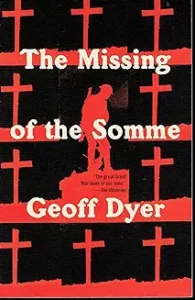The Missing of the Somme by Geoff Dyer 1994
Dyer is one of the very best writers working today. A Brit who is now a professor of creative writing at USC, he has a rare eye for the telling detail, an encyclopedic interest in almost everything in the world, a near perfect sense of irony and humor, and a superb writing style. Add to that, his dry English wit, and you have a winner.
‘The Missing of the Somme’ is the 1oth of Dyer’s books that I’ve read, and not a one of them has been less than terrific. From a novel about Varanesi, India to a narrative of his experiences on a US aircraft carrier, from his criticism of jazz and photography (which won a National Book Critics Award in 2011) to his reflections on aging and final works, Dyer is the real package.
This slim volume was one of his earliest works, but clearly bears the telling marks of his later books—the minor detail carefully described and supporting the central theme; the statistics that support a new slant on old material; the sympathetic and ironic view of mankind; the sweeping and spot-on analysis of the implications of an event.
In this book, Dyer addresses the huge and largely meaningless loss of life experienced by Great Britain in the First World War. He visits cemeteries in Belgium and France where thousands of British dead are buried in ‘unknown solider’ graves as well as some of the best known memorials to the war dead in nearly every town and village in England, Belgium, and France. For perspective, keep in mind that in France there were 30,000 war memorials dedicated between the years 1920-1925, nearly 50 a day. It’s Dyer’s way of exploring “The passion for remembrance, for building memorials and recording the names of the dead… (to provide) solace and comfort in the capacity of ruins to survive the human tragedies they result from and record.”
After visiting many cemeteries and their heroic, often enormous memorials recorded in the register of graves, Dyer ends up at the Somme where 20,000 British soldiers had died and 40,000 had been wounded by 3PM on a single day, July 1, 1916. The Thiepval Memorial there was designed by Lutyens and records “the names of 73,077 men, British and French, who lost their lives here and to whom the fortunes of war denied the honor of a proper burial.” From there, Dyer goes to a cemetery designated Redan Ridge Number One, one of dozens of small burial grounds scattered through the French countryside. There, 154 soldiers lie, 73 unidentified.
Dyer struggles to understand the inestimable loss and futility of these deaths. Among British men under the age of 45, 10% died in WWI, and 60% of the casualties were due to artillery fire with poison gas accounting for many more. Standing in that place of battle, now filled with the peaceful beauty of the site at sunset, Dyer quotes Camus who wrote, “There are more things to admire in men than to despise” and leaves the reader with a sense that the futile loss of lives at the Somme perhaps has a lesson that man might finally learn and ‘make war no more’.
Along the way, Dyer introduces us to the famous war poets, Wilfred Own and Siegfried Sassoon along with some of the dozens of novels spawned by that conflict. Perhaps the most moving quotation, however, is from the American Carl Sandburg who wrote in his poem ‘The Grass’: “And pile them high at Ypres and Verdun./Shovel them under and let me work./Two years, ten years, and passengers ask the conductor:/What place is this?/Where are we now?/I am the grass./Let me work.”
In light of the recent events in Israel and Gaza, in Ukraine and Russia, in Sudan, and in so many other places in the world, I fear that Dyer’s brilliant reflections on the futility and the tragic and ultimately meaningless loss of life in The Great War have fallen on deaf ears. Despite that, this is another book worth reading.



